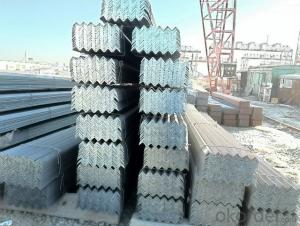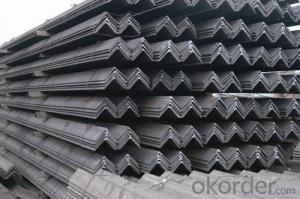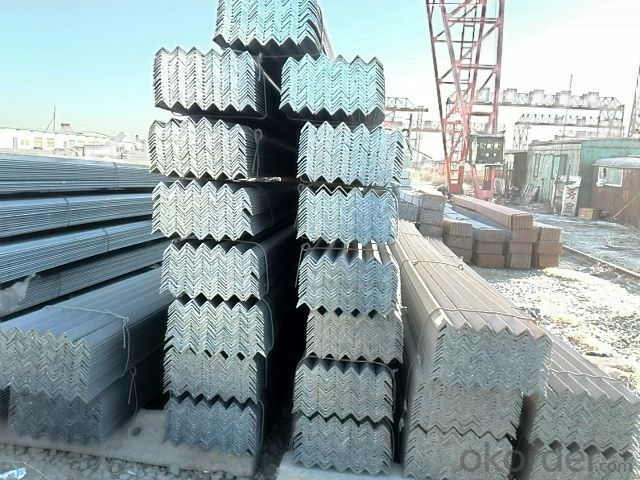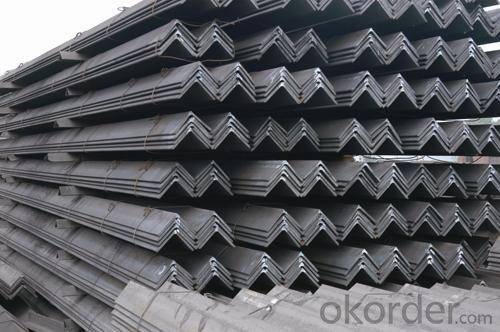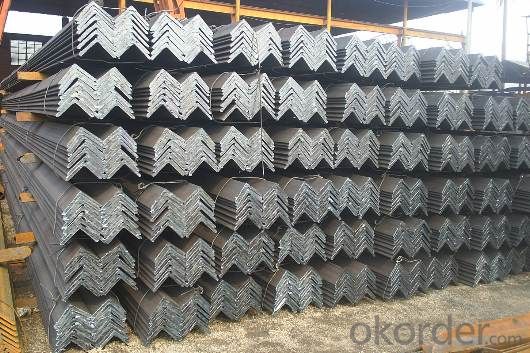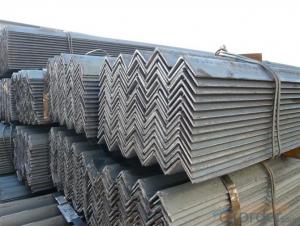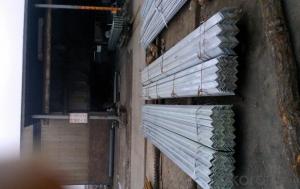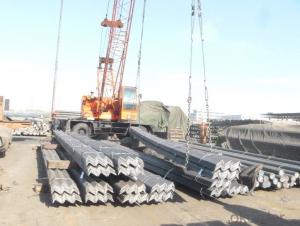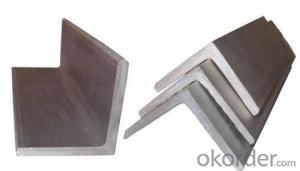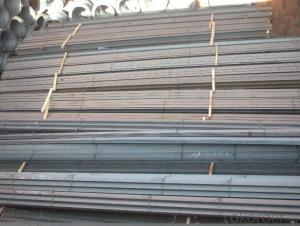Steel angle bar
- Loading Port:
- China Main Port
- Payment Terms:
- TT OR LC
- Min Order Qty:
- -
- Supply Capability:
- -
OKorder Service Pledge
OKorder Financial Service
You Might Also Like
Product Description:
Specifications of Angle Steel
1. Invoicing on theoretical weight or actual weight as customer request
2. Length: 6m, 9m, 12m as following table
3. Sizes
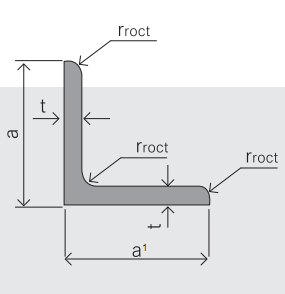
Sizes: 25mm-250mm | ||
a*t | ||
25*2.5-4.0 | 70*6.0-9.0 | 130*9.0-15 |
30*2.5-6.6 | 75*6.0-9.0 | 140*10-14 |
36*3.0-5.0 | 80*5.0-10 | 150*10-20 |
38*2.3-6.0 | 90*7.0-10 | 160*10-16 |
40*3.0-5.0 | 100*6.0-12 | 175*12-15 |
45*4.0-6.0 | 110*8.0-10 | 180*12-18 |
50*4.0-6.0 | 120*6.0-15 | 200*14-25 |
60*4.0-8.0 | 125*8.0-14 | 250*25 |
5. Payment terms:
1).100% irrevocable L/C at sight.
2).30% T/T prepaid and the balance against the copy of B/L.
3).30% T/T prepaid and the balance against L/C
6.Material details:
Alloy No | Grade | Element (%) | | ||||
C | Mn | S | P | Si | | ||
| | |||||||
|
|
|
|
|
|
| |
Q235 | B | 0.12—0.20 | 0.3—0.7 | ≤0.045 | ≤0.045 | ≤0.3 | |
|
|
|
|
|
|
| |
Alloy No | Grade | Yielding strength point( Mpa) | | ||||
Thickness (mm) | | ||||||
≤16 | >16--40 | >40--60 | >60--100 | | |||
≥ | | ||||||
|
|
|
|
|
| | |
Q235 | B | 235 | 225 | 215 | 205 | | |
Alloy No | Grade | Tensile strength (Mpa) | Elongation after fracture (%) | | |||
Thickness (mm) | | ||||||
| ≤16 | >16--40 | >40--60 | >60--100 | | ||
≥ | | ||||||
|
|
|
|
|
|
| |
Q235 | B | 375--500 | 26 | 25 | 24 | 23 | |
Usage & Applications of Angle Steel
According to the needs of different structures, Angle can compose to different force support component, and also can be the connections between components. It is widely used in various building structures and engineering structures such as roof beams, bridges, transmission towers, hoisting machinery and transport machinery, ships, industrial furnaces, reaction tower, container frame and warehouse etc.
Packaging & Delivery of Angle Steel
1. Packing: it is nude packed in bundles by steel wire rod
2. Bundle weight: not more than 3.5MT for bulk vessel; less than 3 MT for container load
3. Marks:
Color marking: There will be color marking on both end of the bundle for the cargo delivered by bulk vessel. That makes it easily to distinguish at the destination port.
Tag mark: there will be tag mark tied up on the bundles. The information usually including supplier logo and name, product name, made in China, shipping marks and other information request by the customer.
If loading by container the marking is not needed, but we will prepare it as customer request.
Production flow of Angle Steel
Material prepare (billet) —heat up—rough rolling—precision rolling—cooling—packing—storage and transportation
- Q: What are the different types of steel angles used in agriculture?
- There are several types of steel angles used in agriculture, including equal angles, unequal angles, and L-shaped angles. These angles are commonly used in the construction of agricultural buildings, equipment, and fencing.
- Q: What are the standard dimensions for unequal leg steel angles?
- The standard dimensions for unequal leg steel angles vary depending on the specific requirements and standards set by different countries and industries. However, commonly used dimensions for unequal leg steel angles include a longer leg length ranging from 1 inch to 6 inches, a shorter leg length ranging from 0.5 inches to 3 inches, and a thickness ranging from 1/8 inch to 1 inch.
- Q: How do you prevent steel angles from vibrating under dynamic loads?
- One possible way to prevent steel angles from vibrating under dynamic loads is by using damping techniques. Damping involves adding materials or structures that absorb or dissipate the energy generated by the vibrating steel angles. This can be achieved by attaching damping pads or strips made of viscoelastic materials to the steel angles, which help absorb and dissipate the vibration energy. Another approach is to incorporate dampers such as tuned mass dampers or friction dampers, which are designed to reduce vibrations by adding additional mass or introducing friction forces to counteract the dynamic loads. Proper design and reinforcement of the steel angles can also help to increase their stiffness and reduce the likelihood of vibration.
- Q: What are the common applications of steel angles?
- Steel angles find extensive use in a multitude of applications owing to their adaptability and robustness. Some prevalent applications of steel angles encompass: 1. Supporting structures: Steel angles are frequently employed as integral components in the construction of buildings and bridges, providing the required fortitude and stability. They serve as beams, columns, and braces, bolstering the structure. 2. Construction: Steel angles play a crucial role in construction endeavors, facilitating the creation of frameworks, supports, and reinforcements. They are adept at forming wall corners, bolstering roof trusses, and enhancing the durability of concrete structures. 3. Machinery and equipment: In the manufacturing of machinery and equipment, steel angles are extensively employed as brackets, frames, and supports for various components. Their utilization ensures stability and structural integrity within these machines. 4. Industrial shelving and racks: Industrial shelving units and racks are frequently constructed using steel angles. These angles provide a robust and dependable structure capable of accommodating heavy items while optimizing storage space. 5. Agricultural equipment: Steel angles are integral to the fabrication of agricultural machinery and equipment, often serving as frames, supports, and brackets for farm implements like plows, cultivators, and harvesters. 6. Fencing and barriers: Steel angles find application in the construction of fences, barriers, and handrails, where their strength and durability are paramount. These angles imbue the structures with the resilience to endure harsh weather conditions and offer enhanced security. 7. Transportation: Vehicles and transportation equipment rely on steel angles during their construction. These angles can be found in truck beds, trailers, and railings, providing the necessary strength and stability for the safe transportation of goods and passengers. 8. Decorative and architectural applications: Steel angles are often utilized for decorative and architectural purposes. They seamlessly integrate into building facades, staircases, and ornamental metalwork, imparting a contemporary and sleek aesthetic while providing structural support. In conclusion, the versatility, durability, and strength of steel angles render them indispensable across a vast array of industries, serving a multitude of purposes.
- Q: What are the common design codes or standards for steel angles?
- Structural design of steel angles is governed by various design codes and standards, which guarantee their compliance with safety and performance criteria. The American Institute of Steel Construction (AISC) Manual of Steel Construction is widely recognized as a crucial design code for steel angles. This manual offers comprehensive guidelines and specifications for the design, fabrication, and erection of steel structures, encompassing angles as well. It provides intricate details regarding design strength, allowable stress levels, and geometric properties of angles. Besides the AISC Manual, other design codes and standards may also apply depending on the specific project and location. These include internationally recognized standards such as the Eurocode, British Standards (BS), and Australian Standards (AS). Each of these standards may have slight variations in their requirements for steel angle design and utilization. Therefore, referring to the relevant standard for a specific project is of utmost importance. Moreover, the American Society for Testing and Materials (ASTM) has established standards for the physical and mechanical properties of steel angles. These standards guarantee that the angles satisfy certain quality and performance requirements. Among the most commonly utilized ASTM standards for steel angles is ASTM A36, which outlines general requirements for carbon structural steel. To ensure structural integrity and reliability, common design codes and standards for steel angles provide guidance on crucial factors such as load capacity, strength, and safety considerations. By adhering to these codes and standards, steel angles are designed and employed in a manner that promotes their structural soundness and dependability.
- Q: Can steel angles be used for window frames?
- Yes, steel angles can be used for window frames. Steel angles provide stability, strength, and durability, making them a suitable choice for supporting and framing windows.
- Q: Can steel angles be used for sign posts?
- Yes, steel angles can be used for sign posts. Steel angles are commonly used in construction due to their strength and durability. They can provide the necessary support and stability for sign posts, especially in areas with high winds or heavy traffic. Additionally, steel angles can be easily welded or bolted together, making them a versatile option for sign post installation. Their resistance to corrosion also ensures a longer lifespan, reducing maintenance and replacement costs.
- Q: What is the typical lead time for steel angle orders?
- The typical lead time for steel angle orders can vary depending on the supplier and the specific order requirements. However, it is common for lead times to range from a few days to a couple of weeks.
- Q: Can steel angles be used as reinforcements in masonry walls?
- Indeed, masonry walls can utilize steel angles as reinforcements. In construction, steel angles are frequently employed to supply extra strength and support to various structures, including masonry walls. These angles can be strategically positioned within the wall to aid in load distribution and prevent cracking or structural failure. Typically, steel angles are crafted from galvanized or stainless steel, rendering them resistant to corrosion. This characteristic renders them suitable for reinforcing masonry walls, as they can endure the elements and offer enduring support. Moreover, steel angles can be easily tailored to meet the specific requirements of the wall, permitting flexibility in design and reinforcement. All in all, steel angles are a dependable and efficient choice for reinforcing masonry walls.
- Q: Can steel angles be used in bridges?
- Yes, steel angles can be used in bridges. Steel angles are often used as structural elements in bridge construction due to their strength, versatility, and ability to provide support and stability. They can be used in various bridge components such as beams, trusses, and connections, helping to distribute loads and resist forces in bridge structures.
Send your message to us
Steel angle bar
- Loading Port:
- China Main Port
- Payment Terms:
- TT OR LC
- Min Order Qty:
- -
- Supply Capability:
- -
OKorder Service Pledge
OKorder Financial Service
Similar products
Hot products
Hot Searches
Related keywords
